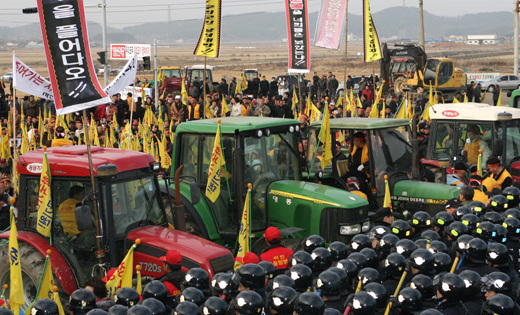 |
|
A pro-reclamation project rally, in which 2,000 residents participated on December 14.
|
Residents seek economic boost, while environmental groups cry foul
A large-scale tidal flats reclamation project covering 12.3 million square meters near South Korea's western sea is emerging as one of the most massive environmental disputes of recent years. Residents, the local government, and environmental groups have sparred over the matter for the past six months, while the central government has not offered any solution. The project, which aims build an industrial complex in Janghang, Seocheon County, South Chungcheong Province, is one of the largest reclamation projects in South Korea's history. Diverging voices On December 14, about 2,000 residents of Seocheon County took to the streets, marching and riding their tractors, calling for the government to immediately begin building the Janghang Industrial Complex. Ahead of the demonstration, several local government officials, including Na So-yeol, head of Seocheon County, held a hunger strike because of the project's slow progress. The protesters argued that their survival depends on the construction of the complex, saying the county's population has fallen to about 50,000 from 150,000 due to a lack of economic stimulation. In contrast, environmental groups and fishermen from the county held a rally in a Seoul government building and demanded the government stop the reclamation project, citing massive environmental destruction.A controversial development In 1989, the Ministry of Construction and Transportation picked tidal flats in Seocheon County as the site for a state-run industrial complex. However, after the completion of partial financing and some road construction, the project has been bogged down due to a failure to accurately calculate demand, as industrial parks near the site have not been taken advantage of by investors. Only 35 percent of available space has been filled at an industrial complex in nearby Gunsan, which was completed earlier this year, and another planned industrial park in nearby Seokmoon was left with just one dam completed due to lack of investors' interest. Assessment on transportation needs and environmental impact began in 2004, but the project lost momentum again when the government balked at another massive reclamation project after the large-scale protests and warnings from the Ministry of the Environment regarding the Saemangeum reclamation project, located just 10 km from the Janghan complex. Korea Land Corp., which is in charge of the Janghang reclamation project, has sent its environmental assessments to the Ministry of Maritime and Fisheries three times, but the ministry has not yet responded. Seocheon County claims that the economic value of the industrial complex will be 80 times greater than maintaining the wetlands. The industrial complex will create 2.6 trillion won (US$2.7 billion) in yearly profits, it said, while the wetland's annual value is worth 33.3 billion won. However, environmental groups accused the county of exaggerating the industrial complex's value. In addition, opinions are divided over the status of the wetlands' ecosystem. Seocheon County argues that the wetland is barren of shellfish, but some academics say the wetland is fully healthy. What's more, Seocheon County accused the government of possessing a double standard, given the nearly-completed construction of the industrial complex in Gunsan. Are there any alternatives? Since June, the government has proposed building an alternative industrial complex on dry land in Seocheon County or to scale back the size of the planned reclamation project. However, Seocheon County has rejected both offers, saying economic benefits will drop if they agree to either scenario. Another proposal was made to build the world's largest aquarium and botanical exhibition center at the planned site, but that proposal was also rejected. In response, a state affairs coordination committee offered Seocheon County to form a special committee between residents and government officials to make a conclusion by February next year, but the county's chief also refused to do so, saying that this plan would amount to starting from scratch. With the divisions remaining deep over the situation, some have pointed out the lack of objective investigation into the project on both sides. Woo Dong-sik, an official at the presidential committee of sustainable development, said, "So far, no state research has been done on the Janghang Industrial Complex's environmental impact and economic benefits." Please direct questions or comments to [englishhani@hani.co.kr]





